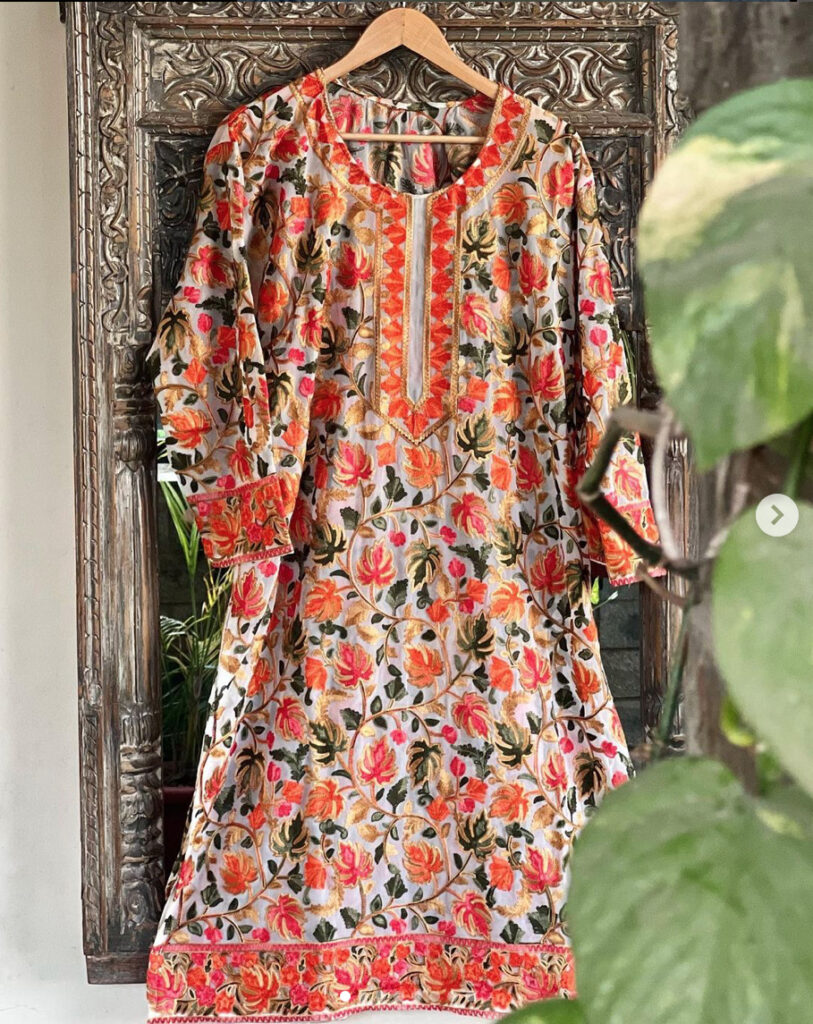Kashmir is where shopaholics and wanderers find their Utopia. Kashmiri embroidery, or Kashidakari, is known for its intricate and finely-detailed patterns, often inspired by nature, flora, fauna and Persian motifs. A kaleidoscope of colours, Kashidakari is a way to empower hands when the fields are fallow and it perfectly captures the essence of Kashmir while fusing and weaving stories for generations to relish.
My tryst with Kashidakari
As an army wife, I’ve had the opportunity to explore the beauty of arts and crafts from across the country, buying directly from the artisans, relishing the firsthand narratives behind these traditional handmade crafts. So when my husband got posted to Jammu, the initial surge of excitement that swept over me was the anticipation of the beautiful valleys and the equally mesmerising world of Kashidakari. Visiting the valley is slightly less advisable, but splurging on the lavish spread of embroidered tapestries became our agenda. I spent the next few months exploring the local market. There were shops dedicated to Pashmina shawls with intricate Sozni or Aari work, stalls offering papier-mâché embroidered products, and outlets specialising in crewel-embroidered home furnishings, like cushion covers and curtains.
The nuances of Kashidakari were many and I enjoyed the quest. Here are a few impressions from my glorious finds…

Unravelling the artistry of Kashmiri embroidery
Kashidakari incorporates various types of intricate, free-flowing styles of stitches. It was introduced by Persian Sufis and its evolution spans centuries.
Over the years, under Mughal and British influences, along with local aesthetics, Kashidakari underwent many phases of design and structural changes. But the basic patterns, intricate, delicate and vibrant as they were, remained intact. What the craft experienced was refinement and increased diversity. The iconic paisley motifs are believed to have been introduced during the Mughal era and have remained an integral part of all Kashmiri embroidery. The ‘Chinar’ leaf pattern, representative of the local flora, is commonly found in Kashmiri tapestries. It resembles the maple leaf but the two are different kinds of foliage.
The fine quality of needlework, intricate floral patterns, and Persian aesthetics are integral toKashidakari. In fact, the term Kashidakari itself means to ‘flow freely’ in Persian, and so it perfectly resonates with the identity of Kashmiri embroidery.
The process of buying Kashmiri embroidery is not just a transaction; it’s an experience. It’s an opportunity to immerse yourself in the art, culture and history of the region. Whether you’re a collector, a fashion enthusiast, or simply someone who appreciates fine craftsmanship, it’s a journey that can be both enlightening and rewarding, as it was for me. Here are some of the most prominent crafts that come together as Kashidakari.
Aari work:
Aari work involves chain stitch, which is done using a hooked needle or ‘aari’. The particular technique is used to stitch very fine and detailed work. It is mostly seen on shawls, stoles and fabrics.

Sozni embroidery:
Sozni is a delicate form of handwork that involves fine, uniform stitches. It is done with a single strand of silk thread on pashmina shawls and stoles. Sozni includes intricate florals and paisley patterns.
Tilla work:
Tilla work incorporates the use of metallic threads and sequins to create intricate patterns. This type of embroidery is popular for Kashmiri bridal and festive wear.

Papier-Mâché Embroidery:
This unique three-dimensional blend of embroidery combines paper pulp with fabric. The paper is first moulded into shapes, and then embroidered onto the fabric. It is a very rare and complex form of embroidery, which makes it expensive as well.
Kasida Embroidery:
Kasida embroidery is characterised by its use of chain stitches to create raised patterns. It’s often used to embellish shawls, stoles and home furnishings.
Crewel Work:
Crewel work is a common style that employs wool thread on a cotton base. It is generally bold with vibrant designs featuring floral motifs. Crewel work is mostly done on curtains, cushion covers, and other home linen.
Numdha Work:
Numdha is a type of felted embroidery, where colourful threads are worked onto a thick woollen fabric. It’s used to create rugs and carpets, often featuring bold and geometric designs.
Chain Stitch Embroidery:
Chain stitch is a fundamental form of Kashidakari and it’s commonly used in Kashmiri needlework. It involves creating a series of loops to form a continuous chain-like pattern.
Zalakdozi:
Zalakdozi is an opulent form of embroidery that often incorporates gold and silver threads. It’s known for its intricate designs and is commonly used on ceremonial garments and luxurious home furnishings.
Each of these embroidery crafts carries its unique charm and is a testament to the skill and artistry of the Kashmiri artisans. It is valued worldwide for its unmatched craftsmanship. Efforts to preserve and promote this ancient craft continue to ensure that it thrives for generations to come.
Fun fact
Almost all Kashmiri craftsmen embroider using their right hand. I came across this interesting tidbit while browsing through the dainty creations, understanding the trails of tradition and variety of embroidery techniques. There are very few or no left-handed craftsmen. Also, the men deal with the finer aspects of needlework while the women are responsible for preparing the yarn.

Buying and owning Kashidakari
When buying Kashidakari, it’s essential to assess the quality of the work. Inspecting the stitching, colour vibrancy and overall design is crucial to ensure you’re purchasing an authentic and well-crafted piece. It’s also helpful to ask about the materials used, such as whether the fabric is pure pashmina wool or another blend.
If you plan to hold the embroidery as an investment, consider proper storage and care to maintain its condition. Protect it from environmental factors like light, moisture and pests.
Buying Kashmiri embroidery is a multi-faceted experience that combines the joy of acquiring a beautiful piece of art with the cultural enrichment of understanding the traditions, skills and stories that go into creating these exquisite works. I hope you enjoy and cherish yours!






